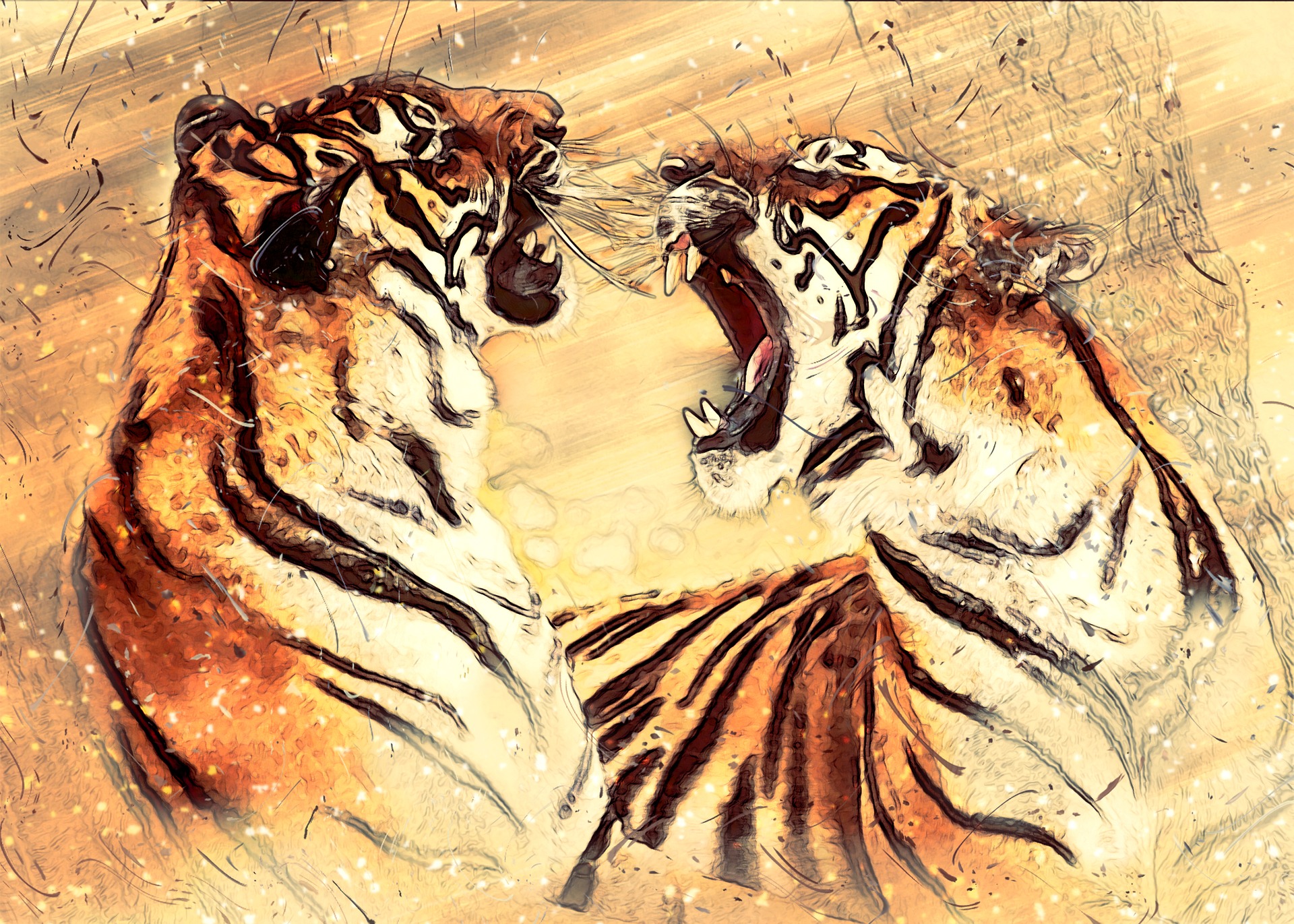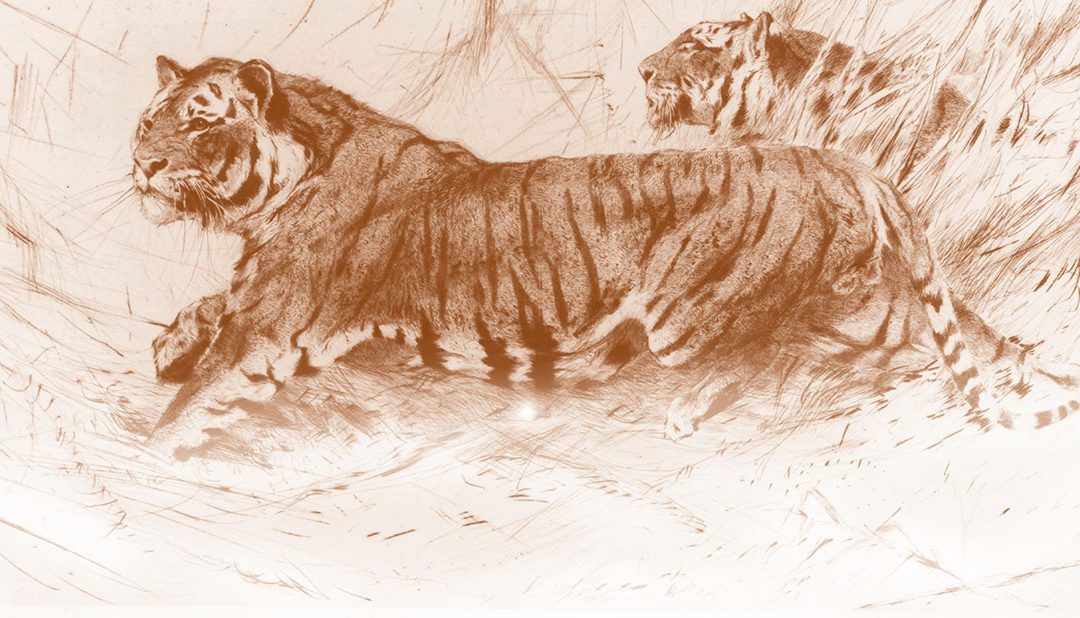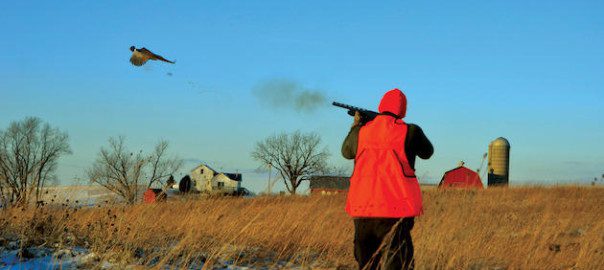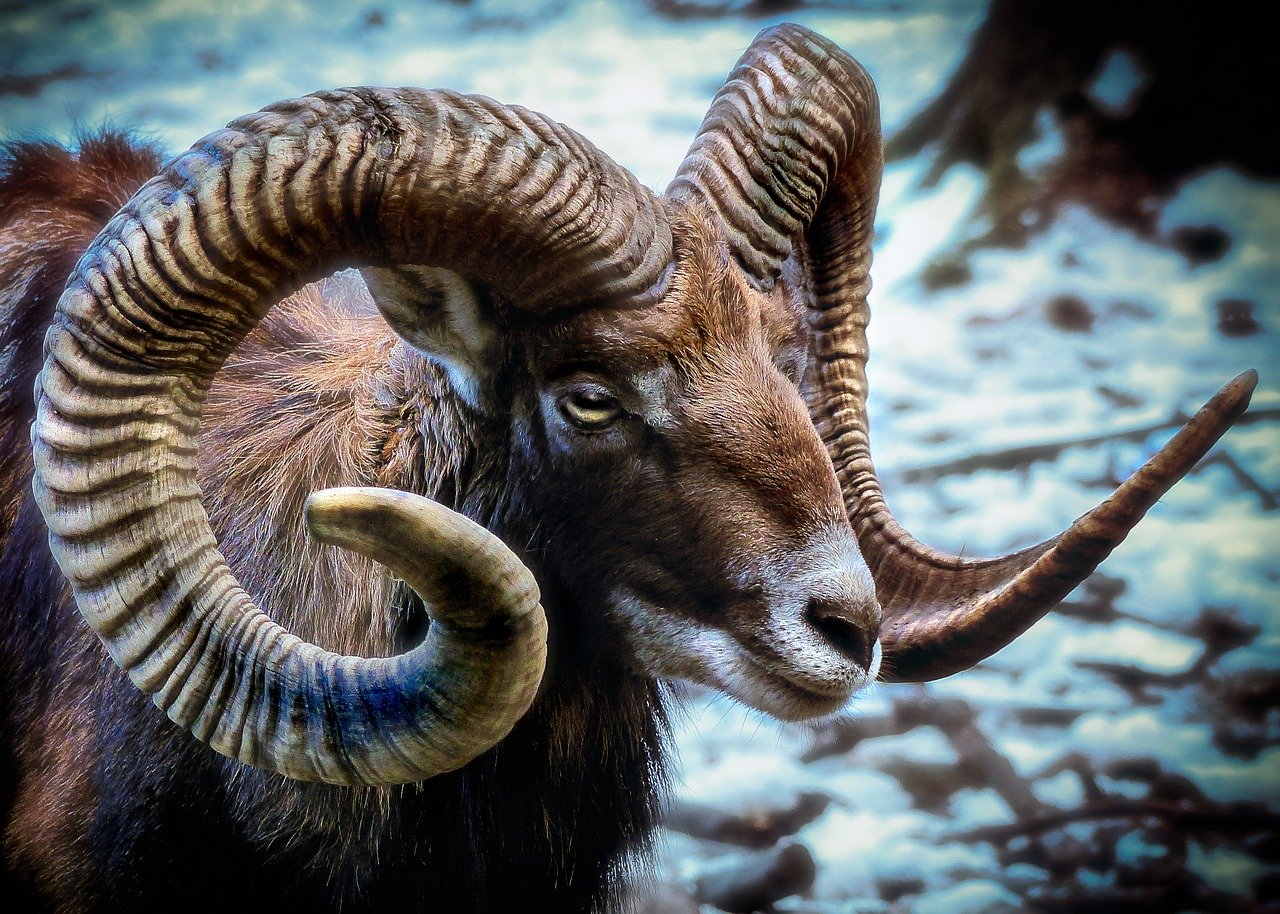An account of a savage fight between two tigers in the jungles of India who fight to the death.
A short time ago I read with much interest an account of a “battle royal” between two bucks in the Maine woods. Fights of this description among wild animals in their native haunts are by no means rare, particularly in the breeding season, but it is not often that one is privileged to witness such a combat.
During my many years in India, in addition to traveling and hunting expeditions in other lands, I have seen several instances, and I will endeavor to describe one, the like of which I shall most likely never see again. And, from the locality, surroundings and good fortune that attended me on the occasion, a similar contest has probably never been witnessed by any big game hunter, even by those who have spent years in the jungle.
I was sitting on the veranda of my bachelor quarters in southern India, mechanically puffing at a Trichinopoly cheroot and lost in the excitement of a stunning French novel when I was disturbed by the “Salaam Sahib” of a soft, mild voice. I knew in a moment it was Ramiah, my head shikarry (hunter). “Salaam Sahib,” he repeated with a most graceful, low-bending bow when he caught my eye.
Then, straightening himself and salaaming again with both hands, he proceeded to inform me that he had “boat atcha kubba” (good news of game), tigers in this instance.
“Do bagh, Sahib” (Two tigers, sir), he continued, his keen black eyes sparkling, and his soft voice full of suppressed excitement and confidence, for Ramiah always became confidential whenever he found that he had touched a tender chord in his master’s heart. He had touched one this time and he knew it, and was making hay while the sun shone.

Illustration by Wilhelm Kuhnert
Ramiah, I may state, was chief (in my eyes) of all my servants, the big adipose Madrasy butler not excepted, for not only was he the most accomplished shikarry I have ever known, but he was faithful and had absolutely no fear.
He had found me more game than any other man had ever done and, on one occasion, had saved my life at the imminent risk of his own when both barrels of my .500 express had failed to stop a charging tigress. I was lying stunned and helpless at the mercy of the infuriated beast, which stood over me, badly wounded and contemplating in her intensified rage whether to tear me to pieces or, while she had the strength, expend that power upon my faithful shikarry who was hurrying toward her.
It was Ramiah, too, whom I saw first when I recovered consciousness, and it was Ramiah who, in some mysterious way that I was never able to understand, had succeeded in stabbing to death the tigress with the hunter’s knife I had given him sometime before, of which he was intensely proud.
Allow me, however, to return to the veranda. Ramiah proceeded, with many gestures and much pointing, to describe the exact position of a certain village some 45 miles away. He proceeded to pinpoint the village’s location on an aerial map while also portraying a picture that I readily understood, and in which I saw sport, fun, a snap of danger, a tinge of glory and an element of disappointment.
It was in the hot weather, and my shikarries were out looking for game. Ramiah had been in the heart of a well-known tiger district, but for some reason or other, tigers were scarce that season. The monsoon had been very heavy and water was plentiful; consequently, the big game animals were scattered, tigers in particular.
Ramiah had heard of two in the neighborhood of the somewhat remote village he had indicated, and had gone there to get kubba (news). He found that a tiger and tigress were hanging around the place and apparently hunting together, a very uncommon procedure on the part of these big cats, which generally seek their prey alone. The beasts had become pretty bold; they had killed several water buffalo belonging to the ryots, or little farmers, and to add sorrow to insult and injury, one of them had made off with a chokera (little native boy) a day or two before Ramiah arrived at my bungalow.
The villagers were in great distress, he told me, and had sent “plenty salaams to master,” begging him to come out and kill the tigers, which I readily consented to do.
I applied for leave immediately, and that night saw to my kit—tent, rifles, etc., for the march to the beleaguered village. I started at dawn next morning on my favorite jungle tat (pony), a half-bred, dun-colored Kathawar, blind of one eye, ewe-necked, flat-sided, crooked legged, short-tailed and vicious, but untiring and unkillable. He was the toughest and ugliest beast I ever owned, but as hard as armor plate and invaluable as a shooting pony.
We rested under a tamarind tree in the middle of the day, and arrived at camp before dark where I found my tent pitched, bath ready and everything prepared as if by the hand of some sweet girl who really had my comfort and welfare at heart.

Illustration by Wilhelm Kuhnert
Verily, the mild Hindoo is a great servant; it matters not what you set him to do, he can do it and do it well. I have had as good dinners in the heart of the Indian jungle, and as well served as I could have had at an expensive hotel, wine not excepted.
I know of nothing on earth to compare with the downright pleasure of a three months’ leave on a big-game shooting trip in India. You take everything and everybody, from butler to tennyketch (cook’s helper), and there is nothing forgotten, from novels to playing cards, soda water to champagne.
On this occasion, however, I was not so particular. I smelled something a little out of the common, nor was I disappointed. Ramiah was at my tent before dawn next morning, sitting on his haunches, waiting for me to get up. Upon my doing so, he told me that nothing had been seen or heard of the tigers that night, and suggested that I should lay up that day, “tie up” for them at night and wait results.
By “tying up” he meant baiting, which consists of buying cows or water buffalo from the natives, and tying them up to trees in the nullahs (dry watercourses) or other likely places in the jungle. They attract the tiger if he is in the neighborhood and, after he has killed one and satisfied his hunger, he retires into the thickest part of the jungle, sleeps through the day, and then comes out again at night to replenish himself from the carcass of his victim.
This he is sure to do if left alone and not disturbed, but seldom is he left to enjoy his sleep in peace and comfort, for at noon, when the sun is hottest and his sleep the soundest, he is surrounded by a cordon of beaters who bring their native musical instruments, tom-toms and antediluvian flintlocks with them and, having received the word, close in on the tiger in a semicircle, making the jungle resound with their shouts, songs, music and firearms.
The hunter is posted at the only part that is free for the tiger to escape without breaking through the beaters, so it is to this quiet spot that he always makes, either to meet his death or else a foe worthy of his steel.
I objected to the shikarry’s suggestion on this occasion, for I felt convinced that as the tigers had not been disturbed, they would return to the village for more cows or more boys, as the case might be and, as the moon was up and the nights very light, I decided to be polite and sit up to receive them.
Accordingly, I bought a young cow, and in the evening, when all the others had been driven into the huts, this heifer was left out, and later on brought into a kind of enclosed yard with low mud walls, at the end of which was a native hut.
The place answered admirably for my purpose; there were no trees, the ground was level and the coast was clear.
I had instructed the natives to make no noise and to leave it all to Ramiah and myself. Accordingly, just as the long Indian day was gliding softly and almost imperceptibly into the short, fleeting hours of night, the heifer was brought to this yard, the sunbaked mud walls of which were about three feet high.
Just before the sun went down, Ramiah and I clambered onto the bamboo and palm-leaf roof of the hut, keeping well out of sight on the farther side and making ourselves as comfortable as possible under the circumstances. Ramiah was at one end and unarmed, except for his knife, which he almost worshiped and invariably wore; myself, with a .500 express, a short distance from him.
 It became intensely dark in a few minutes, then the wretched cow began to bellow piteously. As I lay there with the huge bats and inquisitive flying foxes skimming noiselessly by, at times almost touching us with their vampire wings, I felt as though the moon would never rise. I was especially fearful that the bellowing heifer would bring the tigers down before I would be able to see them.
It became intensely dark in a few minutes, then the wretched cow began to bellow piteously. As I lay there with the huge bats and inquisitive flying foxes skimming noiselessly by, at times almost touching us with their vampire wings, I felt as though the moon would never rise. I was especially fearful that the bellowing heifer would bring the tigers down before I would be able to see them.
At last, however, a silver streak in the east proclaimed the coming of the Queen of Night; and it was only a few moments before she arose in all the glory of her Oriental splendor to silhouette the fantastic and silent figures of the tall and stately distant palms, and give me the longed-for light.
We must have been lying there, hidden as best we could by palm leaves, for an hour and a half when Ramiah, with an almost motionless sign, drew my attention to a couple of dwarf palms. He had seen a tiger pass from one to the other. A moment later, I saw the animal for an instant and then lost track; he seemed to have gone back. We waited and waited, when all at once I saw a tiger crouching along toward the far end of the enclosure nearest to Ramiah; he was about a 150 yards away.
On came the tiger, or tigress, as she proved to be, ’till she got close to the wall and out of sight, so near did she keep to it. Then all at once and, without a moment’s warning, a tiger jumped over the wall on the opposite side.
The tiger crept slowly up to the heifer, crouching low on the ground, exactly like an enormous cat stealing up to a bird or mouse. His tail was carried straight behind him on the ground. Sometimes it gave a nervous twitch, which seemed to denote that he was ready for his spring. His legs would gather under his body, and you would have sworn he was going to make his bound; but no, he would alter his direction and creep on a little farther.
 At last he was in the right position; he had judged his distance to the inch. His bound was sure and his aim was true. He landed with a low growl on the heifer’s shoulder and, seizing the back of her neck with his teeth and placing his enormous paw across her nose and face, gave that awful wrench that dislocates the neck and kills instantly.
At last he was in the right position; he had judged his distance to the inch. His bound was sure and his aim was true. He landed with a low growl on the heifer’s shoulder and, seizing the back of her neck with his teeth and placing his enormous paw across her nose and face, gave that awful wrench that dislocates the neck and kills instantly.
The impact must have been terrific, for she went down as if she had been shot, with the tiger on top. She never moved a limb.
At this moment, the tigress we had seen first, leaped over the wall just about opposite to where the tiger had and walked leisurely up to where her lord and master was calmly lying stretched out, facing his victim.
I honestly believe I could have killed them both, right and left, for the light was excellent, but the drama was too interesting, and I could not ring down the curtain yet.
The tigress then lay down and the tiger got up and, after walking round the carcass of the cow several times, and what appeared to me to be smelling it, he seized it by the neck and dragged it to the wall at the place where he had jumped over. He then elevated his head, still retaining his hold upon the cow and, looking up over the top of the wall, he gathered his hind legs beneath him and made one or two attempts to spring, just as a cat does when trying to jump onto a wall. At about the third crouch, he jumped but did not quite succeed and fell back, cow and all, into the enclosure.
He soon got up and made another attempt with the same result.
Watching all this, the tigress came up and seized the cow just as the tiger had done. She crouched and bounded onto the top of the wall, and then jumped down the other side, dragging the cow with her.
Immediately, the tiger sprang up with a frightful roar, bounded over the wall and attacked the tigress with great fury.
My pen must ever fail to express what followed then. The tigress received the tiger’s charge with a terrible hiss and was onto him in a minute. They stood up and tore and clawed, the tiger appearing much bigger than the tigress. Now he had her by the shoulder; now she was fastened onto his throat, but they did not seem to hold.
In another instant, the tiger had the tigress on her back, and his head appeared buried in her bowels; she was clawing him fearfully down the flanks with both hind legs, while she struck and tore his shoulders and sides with her forepaws.

The tigress appeared to be much the more active of the two, as she was evidently the stronger. She bit and tore again and again, charging the tiger with all the fury of madness every time they seemed for an instant to be relieved from each other’s clutches. I could plainly see that the tigress was too much for her older and less active mate.
For one moment, they separated, and then, with a charge that seemed to carry all the wild deviltry of which her frantically savage nature was capable, her jaws wide open and grinning, the angles of her mouth drawn back, with a hiss that scattered the blood and foam from her nose and mouth, the tigress hurled herself upon her companion, her hunting partner, her mate and, seizing him by the throat, left him dead, stretched upon the crimson sand.
The tigress knew he was dead; she knew she would soon be dead herself, for she was mauled beyond recognition. As she sat there unsteadily upon her haunches, and rooted as it were to the ground, I gazed a moment longer upon a sight I shall never see again. Then, a crack from my rifle, straight for the second stripe behind the shoulder about halfway up, laid her, without a struggle, peacefully beside her dead lord.
Note: This story originally appeared in the June 1900 issue of Outing magazine under the title “A Jungle Duel.”
 Mike Miller’s first sixty-three African safaris—including trips to Zambia, Zimbabwe, Botswana, Mozambique, South Africa, and Cameroon—form the basis for Facing the Charge. A gifted storyteller, writer Scott Longman makes Mike’s African stories come alive on these pages, describing in page-turning detail a tremendous range of experiences during which Mike and his colleagues faced charges from the Big Five—Cape buffalo, lion, leopard, elephant and rhino—as well as from man-eating crocodiles, slithering pythons, vengeful baboons and a hormonal Chevy Tahoe-sized mama hippo who had Mike squarely in her front-view mirror.
Mike Miller’s first sixty-three African safaris—including trips to Zambia, Zimbabwe, Botswana, Mozambique, South Africa, and Cameroon—form the basis for Facing the Charge. A gifted storyteller, writer Scott Longman makes Mike’s African stories come alive on these pages, describing in page-turning detail a tremendous range of experiences during which Mike and his colleagues faced charges from the Big Five—Cape buffalo, lion, leopard, elephant and rhino—as well as from man-eating crocodiles, slithering pythons, vengeful baboons and a hormonal Chevy Tahoe-sized mama hippo who had Mike squarely in her front-view mirror.
In addition to adrenaline-fueled tales of big-game hunting, Facing the Charge details how death was a constant companion on safari in the form of terrorists, quicksand, malaria, and witchcraft, among other threats. It also analyzes how ivory traffickers have devastated the elephant population, examines the everyday hardships of life in Africa, and pays tribute to the men and women who have made Africa a second home for Mike. Facing the Charge appeals to both seasoned African hunters and novices anticipating their first safari, as well as to anyone who enjoys adventure in exotic locations. Shop Now




